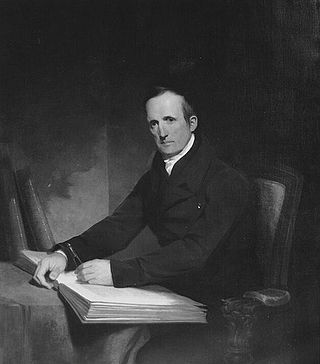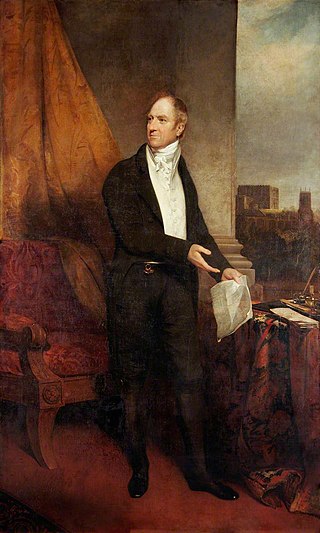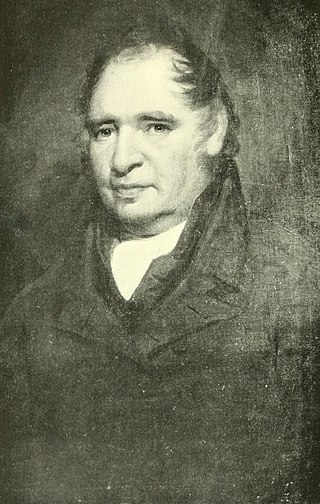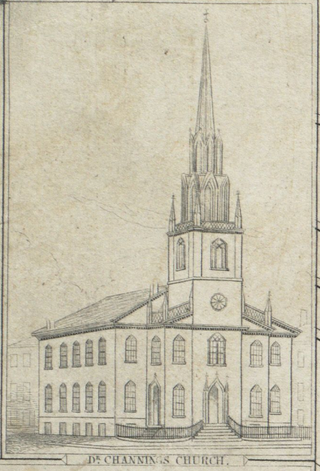
Morris is a town in Litchfield County, Connecticut, United States. The population was 2,256 at the 2020 census.

Charles Bulfinch was an early American architect, and has been regarded by many as the first American-born professional architect to practice.

Jared Sparks was an American historian, educator, and Unitarian minister. He served as President of Harvard College from 1849 to 1853.

Jeremiah Day was an American academic, a Congregational minister and President of Yale College (1817–1846).

Asher Benjamin was an American architect and author whose work transitioned between Federal architecture and the later Greek Revival architecture. His seven handbooks on design deeply influenced the look of cities and towns throughout New England until the Civil War. Builders also copied his plans in the Midwest and in the South.

William Buell Sprague was an American Congregational and Presbyterian clergyman and compiler of Annals of the American Pulpit, a comprehensive biographical dictionary of the leading American Protestant Christian ministers who died before 1850.

William Smith was a leading independent British politician, sitting as Member of Parliament (MP) for more than one constituency. He was an English Dissenter and was instrumental in bringing political rights to that religious minority. He was a friend and close associate of William Wilberforce and a member of the Clapham Sect of social reformers, and was in the forefront of many of their campaigns for social justice, prison reform and philanthropic endeavour, most notably the abolition of slavery. He was the grandfather of pioneer nurse and statistician Florence Nightingale and educationalist Barbara Bodichon, a founder of Girton College, Cambridge.
Andover Newton Theological School (ANTS) was a graduate school and seminary in Newton, Massachusetts. Affiliated with the American Baptist Churches USA and the United Church of Christ. It was the product of a merger between Andover Theological Seminary and Newton Theological Institution. In recent years, it was an official open and affirming seminary, meaning that it was open to students of same-sex attraction or transgender orientation and generally advocated for tolerance of it in church and society.
Unitarianism, as a Christian denominational family of churches, was first defined in Poland-Lithuania and Transylvania in the late 16th century. It was then further developed in England and America until the early 19th century, although theological ancestors are to be found as far back as the early days of Christianity. It matured and reached its classical form in the middle 19th century. Later historical development has been diverse in different countries.

Horace Holley was an American Unitarian minister and president of Transylvania University in Lexington, Kentucky.

Samuel Blatchford was the first president of Rensselaer Polytechnic Institute.

All Souls Unitarian Church is a Unitarian Universalist (UU) church in Tulsa, Oklahoma. It is one of the largest UU congregations in the world.

The Federal Street Church was a congregational Unitarian church in Boston, Massachusetts. Organized in 1727, the originally Presbyterian congregation changed in 1786 to "Congregationalism", then adopted the liberal theology of its fifth Senior Minister, William Ellery Channing, (1780–1842). For most of the 18th century the church was known as the Long Lane Meeting-House. In 1788, state leaders met in the relatively spacious building to determine Massachusetts' ratification of the United States Constitution. Thereafter the church renamed itself the Federal Street Church in honor of the event. In 1803, it called William Ellery Channing, (1780–1842), as its minister who defined "Unitarian Christianity" and launched the Unitarian movement, making the Federal Street Church one of the first to define itself as Unitarian.
Richard Amner (1736–1803) was an English Presbyterian divine.

Charles Alling Gifford was an American architect and a partner in the New York City firm of Gifford & Bates. He is best remembered for his resort hotels, but also designed houses, churches, and five armories for the New Jersey National Guard.

Trenton Falls is a waterfall on West Canada Creek in Trenton, New York. Scenic trails were developed by Brookfield Renewable Power and the Town of Trenton. The falls was and used to produce hydro generated electricity beginning in the early twentieth century, and continues to do so today.

The First Church in Roxbury, also known as the First Church of Roxbury is the current headquarters of the Unitarian Universalist ("UU") Urban Ministry. A church on this site has been in use since 1632 when early English settlers built the first meetinghouse. Since then, the meetinghouse has been rebuilt four times, and its appearance today reflects how the meetinghouse looked in the late 19th and early 20th centuries.

Congregationalism in the United States consists of Protestant churches in the Reformed tradition that have a congregational form of church government and trace their origins mainly to Puritan settlers of colonial New England. Congregational churches in other parts of the world are often related to these in the United States due to American missionary activities.

Mary H. Graves was an American Unitarian minister, literary editor, and writer of the long nineteenth century. After Julia Ward Howe, Graves was the second woman to be ordained within this Christian theological movement.

Eliza R. Sunderland was an American writer, educator, lecturer, and women's rights advocate of the long nineteenth century. She wrote much for literary and religious papers and magazines. She was prominent in her own religious denomination, no woman in the country being called upon more often for addresses at local, state and national Unitarian gatherings than she. She was one of the organizers and the first president of the Western Women's Conference. At the Parliament of the World's Religions in Chicago, in 1893, she represented the Unitarian women of American, and gave of one of the most notable addresses of the parliament. She was especially well-fitted to serve as a member of the board of school visitors in Hartford, Connecticut on account of her lifelong interest in school matters, her experience as a teacher, and her intellectual training.
















